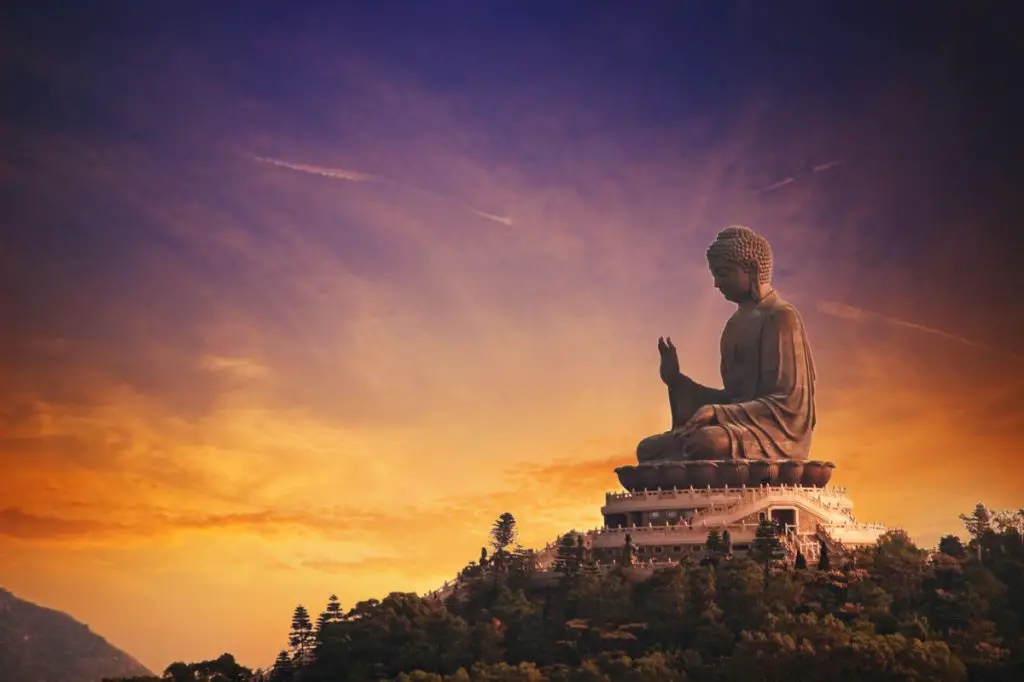In China, statues have a significant historical role since they tell tales of dynasties, emperors, and the development of creative expression. Each monument, with its complex features and symbolic meaning, functions as a cultural time capsule, conserving the essence of China’s rich legacy.
Furthermore, in Chinese art, statues are more than just lifeless objects; they represent spiritual ideas, cultural ideals, and aesthetic experiences. Each statue’s artistry represents the expertise and passion of artisans who have passed their knowledge down through centuries.
In this article, we will look at 23 of the most amazing in China, highlighting useful information about them. I hope to inspire you to plan a trip to some of them.
1.Terracotta Army in Xi’an
Nestled in the heart of China, the Terracotta Army in Xi’an stands as a testament to ancient craftsmanship and strategic burial practices. Unearthed in 1974 by local farmers, this archaeological marvel has since captured the world’s fascination with its historical significance.
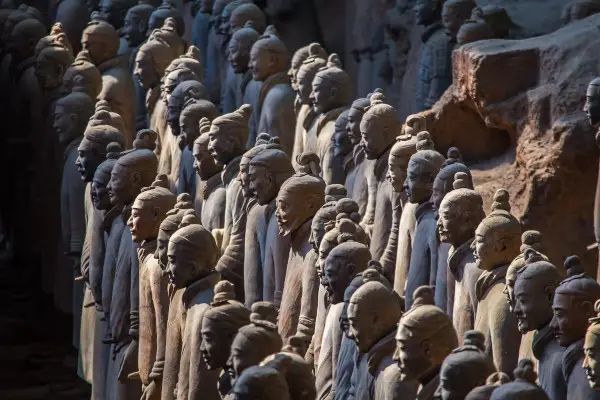
Believed to be constructed during the Qin Dynasty (221–206 BCE), the Terracotta Army served as a protective honor guard for China’s first emperor, Qin Shi Huang, in the afterlife. The meticulous craftsmanship involved in creating these life-sized soldiers reflects the sophistication of ancient Chinese artistry and engineering.
Intriguingly, the Terracotta Army was not just a display of military might but a key component in the emperor’s elaborate burial ritual.
The ancient Chinese believed in an afterlife where the deceased required protection. The Terracotta Army, with its generals, soldiers, and horses, was designed to provide companionship and safeguard the emperor in the next realm.
Each warrior in the army is a unique piece of art, with distinct facial features, hairstyles, and armor, reflecting a commitment to realism that transcends time. Their diversity symbolizes the vast empire under Qin Shi Huang’s rule, showcasing unity in diversity even in the afterlife.
Carefully arranged in battle formation, the Terracotta Army was strategically positioned in different pits to mimic a real army. This positioning was believed to mirror the emperor’s military prowess and tactical brilliance even in death.
| Location | Xi’an, Shaanxi Province, China |
| Height | (life-sized figures) |
| Sculptor | Craftsmen of the Qin Dynasty |
| Material | Terracotta |
| Completed | Discovered in 1974; created during the late third century BCE |
| Coordinates | 34.3840° N, 109.2724° E |
| Nearby attractions | Mausoleum of the First Qin Emperor, Xi’an City Wall, Big Wild Goose Pagoda |
| Best season for a visit | Spring and autumn |
2. The Great Buddha of Leshan
The Great Buddha of Leshan stands as an awe-inspiring testament to ancient craftsmanship and spiritual devotion, nestled at the confluence of the Dadu, Qingyi, and Min rivers. This colossal stone Buddha, carved into the red sandstone cliffs, has been a beacon of tranquility for over 1,200 years.
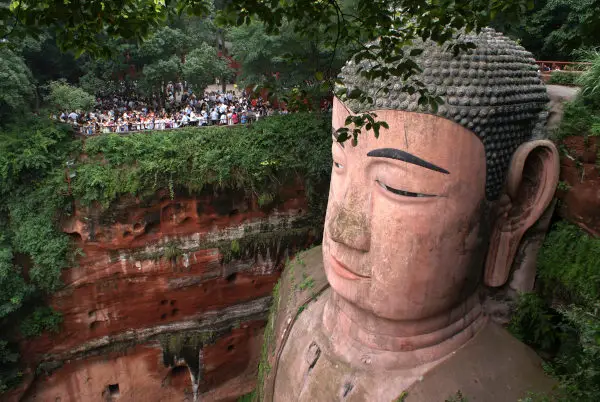
Historical Marvel and Artistic Ingenuity
Crafted during the Tang Dynasty, the Great Buddha of Leshan holds the title of the largest stone Buddha sculpture in the world. The construction, initiated by the monk Haitong, spanned over 90 years and was completed in 803 AD.
The statue reaches a towering height of 71 meters (233 feet), with intricately carved details that capture the serene expression of Buddha. The construction involved removing massive amounts of rock, resulting in the deposited debris altering the river currents.
Cultural and Religious Significance
Beyond its grandeur, the Great Buddha serves as a symbolic guardian, believed to protect the local fishermen from treacherous waters. The colossal presence exudes a sense of shelter and assurance.
Pilgrims and tourists alike flock to Leshan to witness this marvel, contributing to its recognition as a UNESCO World Heritage Site since 1996. The statue’s spiritual aura attracts individuals seeking solace and enlightenment.
The Great Buddha of Leshan has left an indelible mark on Buddhist art, inspiring subsequent generations of sculptures. Its influence resonates not only in China but also across the broader Buddhist world.
| Location | Leshan, Sichuan Province, China |
| Height | 71 meters (233 feet) |
| Sculptor | Haitong |
| Material | Red sandstone |
| Completed | Construction began in 713 AD and completed in 803 AD |
| Coordinates | 29.54472°N 103.77333°E |
| Nearby attractions | Mount Emei, Lingyun Temple, Wuyou Temple |
| Best season for a visit | Spring and autumn |
Related reading: Winter Vacations in China: Best Places to Visit – Things to Do – Travel Tips – Opens in new tab
3. Spring Temple Buddha in Henan
Nestled in the lush landscapes of Henan province, the Spring Temple Buddha rises majestically, claiming the title of the world’s tallest statue. This colossal masterpiece stands at a staggering height of 128 meters (420 feet), a beacon of serenity that captivates visitors from far and wide.

Construction and Engineering Marvels
In tracing the roots of this monumental marvel, the Spring Temple Buddha’s construction unfolded as a feat of engineering ingenuity. The statue, completed in 2008, required meticulous planning and execution:
Crafted from copper alloy, the statue’s sheer scale demanded intricate engineering. The amalgamation of traditional craftsmanship and modern engineering techniques resulted in this towering testament.
The colossal statue stands atop a vast lotus pedestal, ingeniously designed to ensure stability against natural elements. The construction involved a harmonious blend of architectural prowess and spiritual symbolism.
Symbolism and Spiritual Importance
The Spring Temple Buddha transcends its physical stature, embodying profound symbolism and spiritual significance:
- Buddhist Reverence: A representation of Vairocana Buddha, a central figure in East Asian Buddhism, the statue serves as a symbol of enlightenment and universal compassion. Pilgrims and tourists alike flock to witness this embodiment of Buddhist teachings.
- Healing Waters: Adjacent to the statue, a serene pool reflects the Buddha’s image, creating an atmosphere of tranquility and spiritual reflection. The surrounding gardens and scenic beauty add to the holistic experience for visitors.
- Global Unity: Beyond its religious connotations, the Spring Temple Buddha advocates for global harmony. The monument’s construction was a collaborative effort, involving artisans, engineers, and materials from various nations, fostering a sense of unity in diversity.
| Location | Lushan County, Henan Province, China |
| Height | 128 meters (420 feet) |
| Sculptor | Han Meilin |
| Material | Copper and steel |
| Completed | Construction completed in 2008 |
| Coordinates | 33.7708° N, 112.4438° E |
| Nearby attractions | Funiu Mountain, White Horse Temple |
| Best season for a visit | Spring and early autumn |
4. Guan Yu Statue in Yuncheng
Amidst the cultural tapestry of Yuncheng, the statue of Guan Yu stands as a formidable tribute to a legendary warrior. Towering with a commanding presence, this monument encapsulates the heroic spirit of Guan Yu, a figure deeply ingrained in Chinese history and folklore.
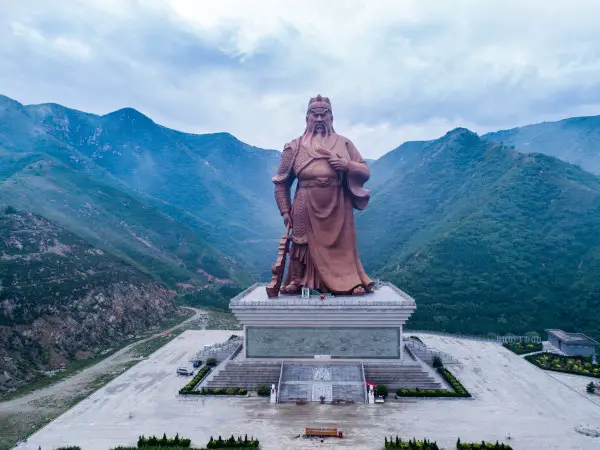
Guan Yu was a revered general during the Three Kingdoms period. The statue pays homage to this iconic figure, immortalizing his contributions and virtues.
The Guan Yu Statue in Yuncheng is not merely a sculpture; it’s a canvas that paints a vivid picture of artistic finesse and cultural significance:
- Regal Pose: Standing at an imposing height, the statue captures Guan Yu in a regal pose, wielding his signature weapon, the Green Dragon Crescent Blade. The details in his armor and facial expression showcase the craftsmanship’s meticulous attention to historical accuracy.
- Cultural Pilgrimage: Locals and visitors alike embark on a cultural pilgrimage to witness this imposing statue. The site has become a focal point for those seeking to connect with China’s historical roots and the enduring spirit of Guan Yu.
- Symbol of Virtue: Beyond the martial aspect, the statue symbolizes virtues like loyalty, righteousness, and integrity. Guan Yu’s legacy extends beyond the battlefield, influencing moral ideals and ethical principles in Chinese culture.
| Location | Yuncheng, Shanxi Province, China |
| Height | 61 meters (190 feet) |
| Completed | Construction completed in 2016 |
| Coordinates | 34.9170°N 110.9640°E |
| Nearby attractions | Guan Yu Temple, Yanhu Scenic Area |
| Best season for a visit | Spring and autumn |
5. Guan Yu Statue at the Guan Gong Cultural Park in Jingzhou city
This is another statue of Guan Gong, located in the heart of Jingzhou city. Guan Yu, a revered figure from the Three Kingdoms period, was a general known for his loyalty, integrity, and martial prowess. The statue, towering at 58 meters (190 feet), pays homage to this legendary warrior, immortalizing a crucial chapter in China’s past.
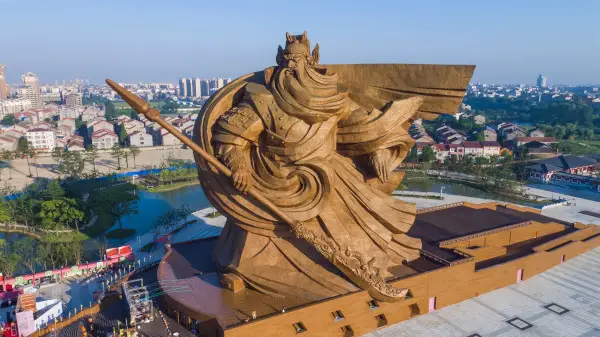
Symbolism in the Statue
The stern yet benevolent gaze of Guan Yu reflects qualities of honor, righteousness, and protection. The statue’s raised weapon signifies bravery and a commitment to justice. In the eyes of many, Guan Yu embodies the virtues that transcend time, making this statue a revered symbol of inspiration and guidance.
Artistic Details and Cultural Impact
Crafted with meticulous attention to detail, the Guan Yu Statue is a masterpiece of artistry. From the intricate armor that adorns the warrior to the flowing beard that signifies wisdom, every detail tells a story. The craftsmanship not only captures the essence of Guan Yu’s character but also showcases the skill and dedication of the artisans involved.
The cultural impact of the Guan Yu Statue extends beyond its artistic appeal. It serves as a cultural touchstone, drawing visitors and locals alike to reflect on the historical legacy it represents. As a destination within the Guan Gong Cultural Park, this statue contributes to the preservation and celebration of China’s rich heritage, fostering a deeper connection between past and present.
| Location | Guan Gong Cultural Park, Jingzhou City |
| Height | 58 meters (190 feet) |
| Designer | Han Meilin |
| Material | Steel framing, reinforced by concrete, bronze strips |
| Completed | Construction completed in 2016 |
| Coordinates | 30°20’31.0″N 112°12’28.0″E |
| Nearby attractions | Jingzhou Ancient City Wall, Jingzhou Museum |
| Best season for a visit | Spring and autumn |
6. Confucius Statue in Qufu
Nestled in the historic city of Qufu, the tallest Confucius Statue stands as a majestic tribute to one of China’s greatest philosophers. Towering with grace, the statue captures the essence of Confucius, a revered figure whose teachings have shaped the moral and philosophical landscape of Chinese civilization.
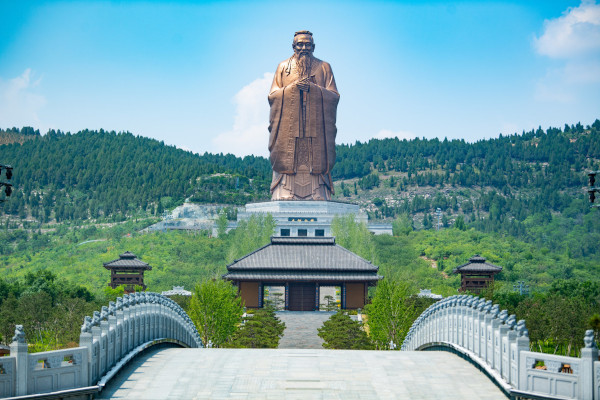
Connection to the Teachings of Confucianism
The statue is more than a mere representation; it serves as a living embodiment of Confucian values. With a serene countenance and dignified posture, Confucius’s statue echoes the principles of benevolence, filial piety, and moral integrity that are at the core of Confucianism. It stands as a visual reminder of the timeless wisdom imparted by Confucius, encouraging visitors to reflect on the profound teachings that have endured for centuries.
Importance in Promoting Traditional Values
As a symbol of respect for authority, familial ties, and ethical conduct, the statue fosters a sense of cultural continuity. In a rapidly evolving world, the Confucius Statue stands as a grounding force, inspiring individuals to uphold the enduring principles that have been integral to China’s cultural fabric.
The statue’s location in Qufu, Confucius’s hometown, adds a layer of significance, turning it into a pilgrimage site for those seeking a deeper understanding of Chinese philosophy and heritage.
| Location | Qufu, Shandong Province, China |
| Height | 72 meters (236.2 feet) |
| Material | Bronze |
| Completed | Unveiled in 2018 |
| Coordinates | 35°29’43.8″N, 117°12’19.1″E |
| Nearby attractions | Temple of Confucius, Cemetery of Confucius, Kong Family Mansion |
| Best season for a visit | Spring and autumn |
7. Emperor Qin Shi Huang Statue in Xianyang
Standing regally in Xianyang, the Emperor Qin Shi Huang Statue pays homage to the visionary leader who unified China over two millennia ago. Crafted with precision and artistry, this statue stands as a formidable tribute to the first emperor, leaving an indelible mark on the city’s landscape.
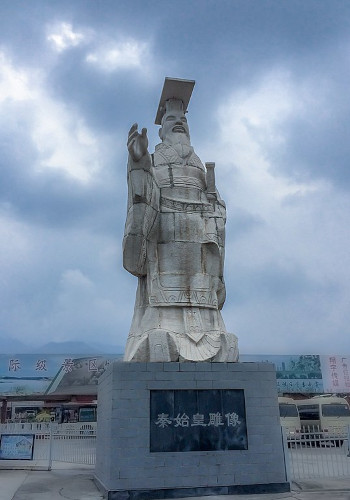
Historical Achievements and Controversies
The statue serves as a tangible reminder of Emperor Qin Shi Huang’s remarkable achievements and, at the same time, sparks contemplation on the controversies that surround his legacy. Known for constructing the Great Wall and standardizing measurements, the first emperor left an enduring imprint on Chinese history. However, his authoritarian rule and the infamous Qin Dynasty’s burning of books and burying of scholars also evoke a complex legacy.
Depiction of Qin Shi Huang’s Legacy through the Statue
The Emperor Qin Shi Huang Statue skillfully captures the dichotomy of his legacy. With a gaze that exudes authority and determination, the statue reflects the ruler’s ambition to create a united and powerful China. The intricacies of the imperial robe and the symbolism embedded in the statue’s posture encapsulate the grandeur of an era marked by both conquest and controversy.
As visitors stand before this monumental statue, they are prompted to ponder the multifaceted nature of history, acknowledging the accomplishments and challenges that define the reign of Qin Shi Huang.
| Location | Xianyang |
| Material | Marble |
| Completed | Uncertain- Discovered by chance in 1974 |
| Coordinates | 34°23’05.0″N 109°16’23.0″E |
| Nearby attractions | Mausoleum of Qin Shi Huang, Han Yang Ling Museum |
| Best season for a visit | Autumn |
8. Statues of the Yan Emperor and the Yellow Emperor at Zhengzhou
In the heart of Zhengzhou, two remarkable statues stand tall, paying homage to the revered figures of the Yan Emperor and the Yellow Emperor. These legendary emperors, central to Chinese mythology and history, are celebrated through imposing statues that capture the imagination of those who visit.
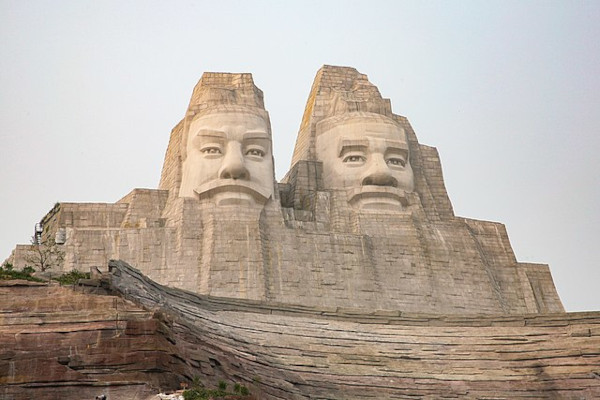
Symbolism in the Statue
The statues of the Yan Emperor and the Yellow Emperor are not just sculptures; they are symbols deeply intertwined with the cultural fabric of China. The Yan Emperor, considered the progenitor of Chinese civilization, symbolizes the origins of the Chinese people. The Yellow Emperor, a mythical sage-king, embodies the harmonious relationship between humanity and the cosmos. Together, these statues represent the roots and values that have shaped Chinese identity.
Artistic Details and Cultural Impact
Crafted with meticulous attention to detail, the statues showcase the artistic prowess of those who brought these monumental figures to life. The flowing robes, regal postures, and intricate accessories breathe life into the emperors of ancient times. Beyond their aesthetic appeal, the statues have a profound cultural impact, serving as touchstones for those seeking a connection to China’s ancient past.
| Location | Yan Huang Plaza, Zhengzhou, Henan, China |
| Material | Real stone from Taihang Mountains |
| Height | Overall 106 meters (347.7 feet) |
| Completed | Yan Emperor Statue unveiled in 2007, Yellow Emperor Statue unveiled in 2008 |
| Coordinates | 34.9514°N 113.5110°E |
| Nearby attractions | Henan Museum, Shang Dynasty Ruins |
| Best season for a visit | Spring and autumn |
9. Laozi Statue in Laojun Mountain
High amidst the serene landscapes of Laojun Mountain, the Laozi Statue stands as a tribute to the enigmatic philosopher Laozi, a central figure in Taoism. Laozi, credited with the authorship of the Tao Te Ching, is shrouded in mystery, and the statue serves as a beacon inviting contemplation on the profound wisdom he left behind.
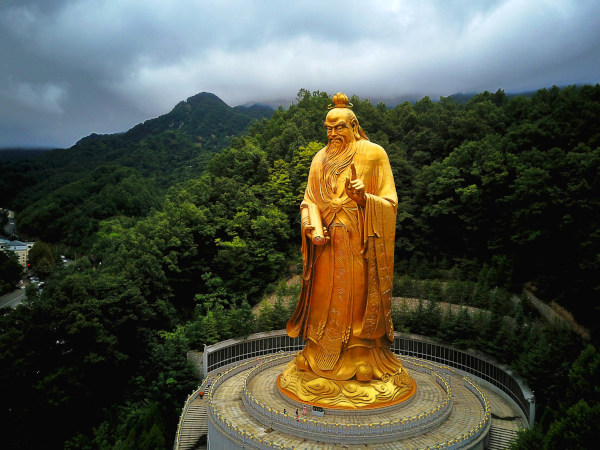
Artistic Representation and Symbolism in the Statue
The Laozi Statue is not just a physical representation but a symbolic embodiment of Taoist philosophy. The statue’s serene countenance and tranquil posture mirror the essence of Laozi’s teachings, emphasizing simplicity, harmony, and the interconnectedness of all things. Symbolic elements, such as the Daoist robe and the yin-yang motif, add layers of meaning, inviting onlookers to delve into the depth of Taoist principles.
Connection to Taoist Philosophy and Teachings
Set against the backdrop of Laojun Mountain, the Laozi Statue creates a spiritual nexus with Taoist philosophy. It acts as a conduit for those seeking a connection to the Tao, the fundamental force that permeates the universe according to Laozi’s teachings. The statue serves as a reminder to embrace the natural flow of life, to find balance in opposites, and to cultivate a sense of inner harmony in a world often marked by chaos.
As visitors stand before the Laozi Statue, they are encouraged to reflect on the timeless wisdom encapsulated in Taoist philosophy and the enduring legacy of Laozi.
| Location | Laojun Mountain |
| Material | Bronze |
| Height | 38m (124.6 feet) |
| Completed | 2010 |
| Coordinates | 33°45’16.7″N 111°38’30.9″E |
| Nearby attractions | Taiqing Palace, Baiyun Temple |
| Best season for a visit | Summer and early autumn |
10. Statue of Zhuge Liang in Xiangyang
In the city of Xiangyang, the Statue of Zhuge Liang stands as a tribute to one of the most brilliant military strategists in Chinese history. Zhuge Liang, also known as Kongming, played a pivotal role during the Three Kingdoms period, serving as the chief strategist for the Shu Han state. The statue, set against the historical backdrop of Xiangyang, pays homage to the wisdom and strategic acumen of this revered figure.
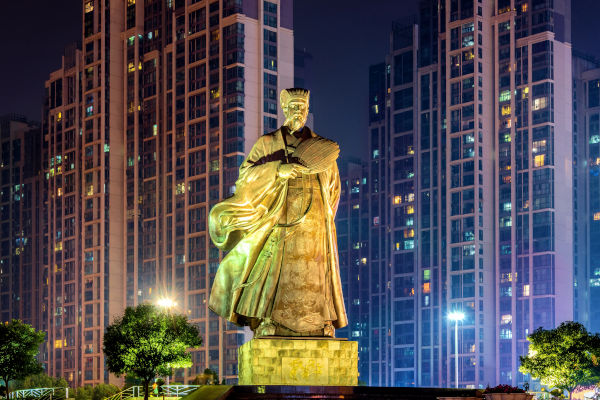
Symbolism in the Statue
Zhuge Liang’s figure, with a feathered fan in hand, embodies not only military prowess but also wisdom, intellect, and foresight. The statue’s gaze reflects the strategic brilliance that guided the Shu Han state through challenging times. It stands as a symbol of sagacity and leadership, resonating with admirers of military history and wisdom seekers alike.
Artistic Details and Cultural Impact
Crafted with meticulous attention to detail, the artistic rendering of Zhuge Liang’s statue captures the essence of his character. From the intricate design of his robe to the poised expression, every element reflects the grace and intellect of this legendary figure. The presence of the Statue of Zhuge Liang in Xiangyang adds to the city’s cultural allure, making it not just a historical site but a living testament to the enduring legacy of one of China’s greatest military strategists.
| Location | Xiangyang, Hubei Province, China |
| Height | 33 meters (108 feet) |
| Material | Bronze |
| Completed | Construction completed in 2008 |
| Coordinates | 32°03’42.9″N 112°07’37.6″E |
| Nearby attractions | Xiangyang Ancient City Wall, Liu Bei’s Temple, Fancheng District |
| Best season for a visit | Spring and autumn |
11. Statue of Yue Fei in Hangzhou (Yue Fei Temple)
In the revered grounds of the Yue Fei Temple in Hangzhou, the imposing Statue of Yue Fei stands tall, honoring a man whose unwavering loyalty and patriotism have etched his name into the annals of Chinese history. Yue Fei, a valiant general of the Southern Song Dynasty, is venerated for his selfless devotion to the nation and the sacrifices he made for the greater good.
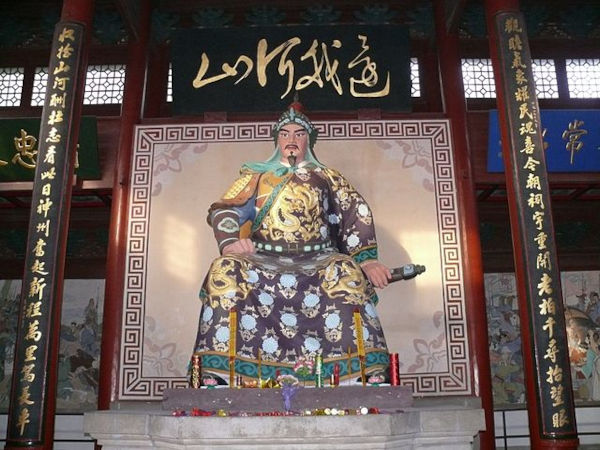
Historical Context and the Statue’s Symbolism
As visitors enter the temple grounds, they are transported back to a time when Yue Fei’s military brilliance and unyielding loyalty became instrumental in safeguarding the sovereignty of China. The statue, with its resolute posture and emblematic armor, encapsulates Yue Fei’s commitment to defending his homeland.
The symbolism embedded in the statue is a reflection of Yue Fei’s ethos—his unwavering gaze symbolizes determination, and a readiness to protect. It stands as a powerful tribute to a hero whose legacy transcends centuries, resonating with the very spirit of Chinese resilience.
Visitors to the Yue Fei Temple are not only immersed in history but are also invited to reflect on the timeless ideals embodied by Yue Fei, fostering a deeper appreciation for the virtues that continue to shape the cultural narrative of China.
| Location | Hangzhou, Zhejiang Province, China |
| Coordinates | 30°15’09.9″N 120°08’09.8″E |
| Nearby attractions | West Lake, Lingyin Temple, Six Harmonies Pagoda |
| Best season for a visit | Spring and autumn |
12. The Eight Immortals Statue in Penglai
Nestled in the enchanting realm of Penglai, the Eight Immortals Statue pays homage to legendary figures steeped in Chinese mythology. The Eight Immortals, a group of revered beings, each possessing unique powers, embark on celestial adventures that weave through the tapestry of Chinese folklore. The statue stands as a collective tribute to these immortal beings, symbolizing their enduring presence in cultural narratives.

Artistic Representation and Symbolism in the Statue
Crafted with artistic finesse, the Eight Immortals Statue is a masterpiece that captures the essence of each immortal. From the ageless beauty of He Xiangu to the whimsical charm of Han Xiangzi, every detail is meticulously carved, creating a tableau of mythical personalities.
The symbolism embedded in the statue reflects the diverse attributes of the Eight Immortals—whether it’s Lan Caihe’s flower basket or Lu Dongbin’s sword, each element tells a story of transcendence and mystical prowess.
The Eight Immortals, with origins dating back to ancient texts and stories, have become symbolic embodiments of Daoist principles. The statue serves as a visual representation of their transcendental journey, encapsulating the Taoist ideals of harmony, balance, and the pursuit of enlightenment.
| Location | Penglai, Shandong Province, China |
| Material | Stone |
| Completed | Installation completed at various times |
| Coordinates | 37°49’25.8″N 120°46’30.9″E |
| Nearby attractions | Penglai Pavilion, Danya Mountain, Penglai Water City |
| Best season for a visit | Spring and early autumn |
13. Mao Zedong Statue in Chengdu
In the bustling city of Chengdu, the Mao Zedong Statue stands as a monumental reminder of a pivotal era in Chinese history. Mao Zedong, the founding father of the People’s Republic of China, played a central role in shaping the nation’s destiny during the mid-20th century. His leadership, marked by revolutionary fervor, aimed at transforming China into a socialist state. The statue, situated in Chengdu, speaks to Mao’s enduring influence on the political landscape.
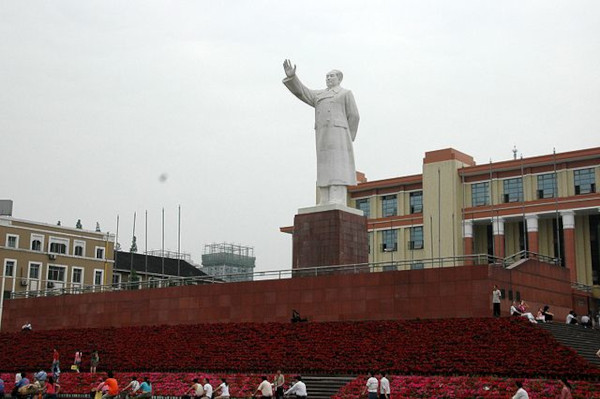
Description of the Statue’s Significance in Modern China
The Mao Zedong Statue holds immense significance in modern China, embodying the ideals and aspirations of the nation’s revolutionary past. The statue’s imposing presence, with Mao’s outstretched arm and determined gaze, symbolizes the resilience and vision that guided China through times of profound change. It serves as a visual representation of the monumental shifts in governance, social structures, and economic policies that characterized Mao’s leadership.
The statue acts as a focal point for those reflecting on China’s journey from a revolutionary state to a global powerhouse. Its location in Chengdu, a city that has witnessed China’s transformation, further underscores the symbolic weight the statue carries in the narrative of the nation’s progress.
Public Perception and Controversies Surrounding the Statue
The Mao Zedong Statue, while revered by some as a symbol of national pride and resilience, is not without controversy. Public perception of the statue varies, with debates surrounding the glorification of Mao’s legacy and the historical complexities of his rule. Some view the statue as a homage to a transformative leader, while others critique it for downplaying the human rights violations and political purges associated with Mao’s regime.
| Location | Chengdu |
| Material | Bronze |
| Completed | Unveiled in 1967 |
| Coordinates | 30°39′41″N 104°03′48″E |
| Nearby attractions | People’s Park, Jinli Ancient Street |
| Best season for a visit | Spring and autumn |
14. Mazu Statue, Meizhou Island, Fujian
On the tranquil Meizhou Island in Fujian, the Mazu Statue stands as a tribute to Mazu, the revered Chinese sea goddess. Mazu, also known as Tianhou, is a figure deeply intertwined with maritime culture and has been worshipped by sailors and coastal communities for centuries. The statue’s presence on Meizhou Island reflects the historical significance of Mazu as a guardian deity of the seas.
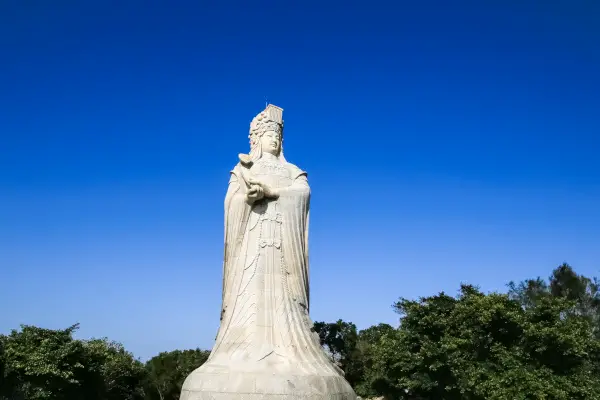
Symbolism in the Statue
The Mazu Statue is a powerful symbol, embodying the protective and benevolent spirit of the sea goddess. With a serene countenance and a gaze that stretches across the vast waters, the statue encapsulates the watchful presence Mazu is believed to have over sailors and fishermen.
The symbolism extends to the elements surrounding the statue, such as the flowing robes and the divine accessories, all of which represent the divine authority and compassion associated with Mazu.
Artistic Details and Cultural Impact
Every detail, from the intricacies of Mazu’s facial expression to the flowing drapery that captures the movement of the wind, adds to the artistic allure of the statue. The cultural impact is profound, as the statue becomes a focal point for locals and visitors alike to express reverence and seek blessings for safe voyages.
As a cultural landmark on Meizhou Island, the Mazu Statue is not only a testament to artistic craftsmanship but also a living embodiment of the spiritual connection between coastal communities and the sea goddess. It serves as a beacon of hope and protection, instilling a sense of comfort and tradition among those who depend on the oceans for their livelihoods.
| Location | Meizhou Island, Fujian |
| Material | Granite |
| Completed | Completed in 2009 |
| Coordinates | 25°04’35.5″N 119°07’33.7″E |
| Nearby attractions | Meizhou Mazu Temple, Tianhou Palace |
| Best season for a visit | Spring and early autumn |
15. Statue of Guan Yin of the South Sea of Sanya, Hainan
The Guan Yin of the South Sea, gracefully overlooking the azure waters of Sanya in Hainan, has roots embedded in the rich tapestry of Chinese Buddhism. The statue, a manifestation of Guan Yin, the bodhisattva of compassion, finds its historical context in the spiritual landscape of China. As a symbol of mercy and salvation, Guan Yin has been venerated for centuries, and the statue in Sanya serves as a contemporary testament to this enduring devotion.

Symbolism in the Statue
The Guan Yin of the South Sea Statue is a profound symbol of compassion and spiritual solace. The statue features three faces, one gazing inland and the other two looking out to the South China Sea. The many facets signify Guanyin’s blessing and protection over China and the rest of the world.
Each of the three connected facets holds a different symbol in its hands; a string of Buddha beads, a lotus, and a small case, signifying generosity, serenity, and wisdom. The statue, which is erected on a lotus throne with 108 petals, appears to be exceedingly spiritual. The posture of the statue, standing amidst the waves, symbolizes Guan Yin’s ability to provide guidance and support in the turbulent seas of life.
Each element, from the flowing robes to the serene expression, contributes to the symbolic richness that defines the Guan Yin of the South Sea.
Artistic Details and Cultural Impact
Over 220 pounds (100 kg) of gold, hundreds of rubies, sapphires, emeralds, coral, turquoise, and pearls, and over 220 pounds (100 kg) of jade are used to embellish the statue. The delicate features, intricate accessories, and serene aura create an atmosphere of tranquility, inviting devotees and visitors to experience a sense of spiritual serenity.
| Location | Nanshan Cultural Tourism Zone, Sanya, Hainan Province, China |
| Height | 108 meters (354 feet) |
| Material | Mixed metals coated with a fluoropolymer surface coating that is resistant to corrosion from salt. |
| Completed | Unveiled in 2005 |
| Coordinates | 18°17’33.0″N 109°12’30.9″E |
| Nearby attractions | Nanshan Temple, Nanshan Buddhism Culture Park |
| Best season for a visit | Spring and autumn |
16. Dazu Rock Carvings, Chongqing
The Dazu Rock Carvings, located in the scenic hills of Chongqing, bear witness to a rich tapestry of Chinese Buddhist and Taoist history. Dating back to the 7th century, these intricate carvings narrate stories of religious devotion and cultural synthesis. Commissioned during the Tang and Song dynasties, the carvings hold historical significance as a testament to the coexistence of Buddhism, Taoism, and Confucianism in ancient China.
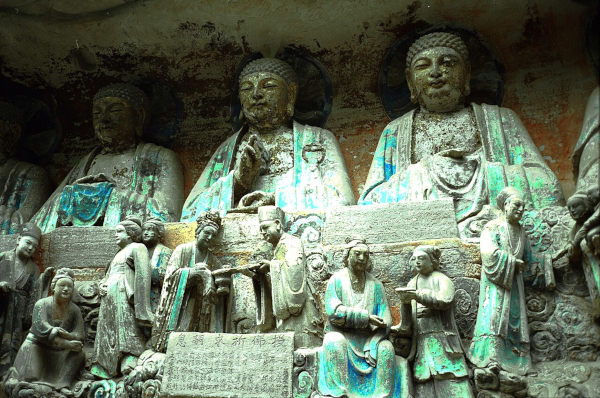
Symbolism in the Carvings
The Dazu Rock Carvings are a symbolic repository of religious and philosophical ideas. Each carving, meticulously etched into the rock faces, conveys layers of symbolism related to Buddhist teachings, Confucian values, and Taoist principles. From depictions of Bodhisattvas to scenes of daily life, the carvings encapsulate a diverse range of symbols that invite contemplation on the interconnectedness of spirituality and everyday existence.
Artistic Details and Cultural Impact
Carved with precision, the intricate details capture the nuances of facial expressions, flowing robes, and divine accessories. The cultural impact extends beyond aesthetics; the carvings serve as a visual encyclopedia of Chinese religious and philosophical thought. Visitors are immersed in a cultural journey, deciphering the symbolism and narratives etched into the rocks, fostering a deeper understanding of the diverse influences that shaped ancient Chinese society.
As a UNESCO World Heritage Site, the Dazu Rock Carvings not only preserve the artistic legacy of ancient China but also provide a unique window into the spiritual and cultural expressions that continue to resonate through the ages.
| Location | Dazu Rock Carvings, Chongqing |
| Material | Sandstone |
| Completed | Carved from the 9th to the 13th century |
| Coordinates | 29°44’40.5″N 105°47’41.4″E |
| Nearby attractions | Baodingshan Rock Carvings, Beishan Rock Carvings |
| Best season for a visit | Spring and autumn |
Related reading: “Top 5 Amazing Natural Places in China“
17. Yellow River Mother Sculpture, Lanzhou, Gansu
Nestled along the banks of the Yellow River in Lanzhou, the Yellow River Mother Sculpture stands as a poignant testament to the historical significance of the river in Chinese civilization. The Yellow River, often referred to as the “Mother River,” has been a cradle of Chinese culture, supporting ancient civilizations and shaping the course of history. The sculpture reflects a deep acknowledgment of the river’s pivotal role in the nation’s narrative.
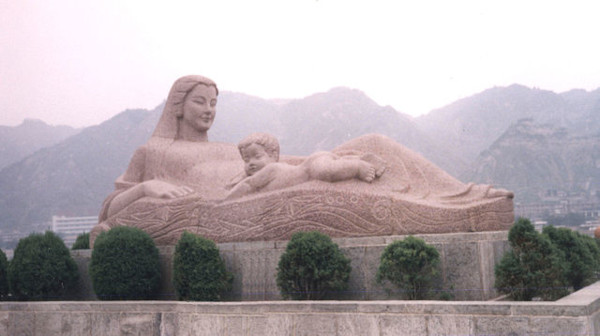
Symbolism in the Sculpture
The statue personifies the river as a nurturing and life-giving force. The motherly figure symbolizes the river’s benevolence and sustenance to the surrounding lands. The flowing drapery and the harmonious pose evoke a sense of maternal protection, underscoring the vital role the Yellow River plays in sustaining life and fostering prosperity.
Artistic Details and Cultural Impact
The sculpture depicts a tall mother resting on her back against the raging Yellow River waves. Her right arm is slightly flexed, and she has a charming smile on her face with lovely hair falling around her shoulders. A cute little child cuddles up to her right side, his eyes twitching to the left as he unintentionally smiles. As a cultural landmark, the sculpture has become an iconic representation of the Yellow River’s cultural and ecological importance.
The cultural impact of the Yellow River Mother Sculpture extends beyond its physical presence. It serves as a visual anchor, inviting contemplation on the symbiotic relationship between nature and civilization, and the profound influence of the Yellow River on the Chinese identity.
| Location | Lanzhou, Gansu Province, China |
| Height | 6 meters (20 feet) |
| Designer | He E |
| Material | Granite |
| Completed | 1986 |
| Coordinates | 36°03’59.3″N 103°47’54.5″E |
| Nearby attractions | Yellow River Scenic Area, White Pagoda Park, Gansu Provincial Museum |
| Best season for a visit | Spring and autumn |
18. Zheng Chenggong Statue, Xiamen, Fujian
Perched along the shores of Xiamen in Fujian, the Zheng Chenggong Statue stands as a tribute to a key figure in Chinese history. Zheng Chenggong, also known as Koxinga, was a Ming loyalist who played a pivotal role in resisting foreign invasions during the 17th century.
The statue’s historical context is rooted in this era of maritime struggles, where Zheng Chenggong’s efforts to reclaim Chinese territory from foreign powers left an indelible mark on the nation’s narrative.
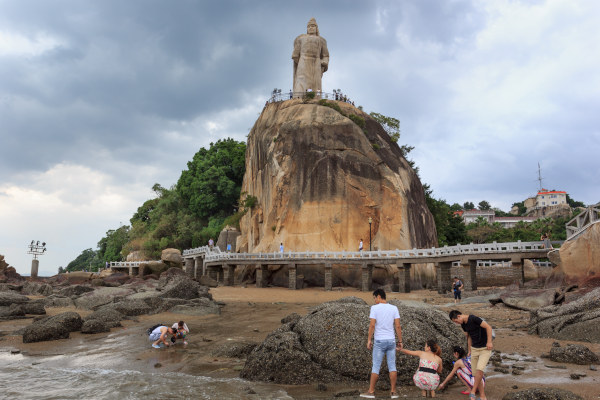
Symbolism in the Statue
The Zheng Chenggong Statue is laden with symbolism that reflects the historical legacy of its namesake. With a commanding presence and resolute posture, the statue embodies Zheng Chenggong’s determination to safeguard Chinese sovereignty.
Artistic Details and Cultural Impact
The intricate details, from the facial features to the ornate attire, breathe life into the statue, making it more than a representation but a visual testament to a significant chapter in Chinese history. As a cultural landmark in Xiamen, the statue has a profound impact, serving as a reminder of resilience and national pride. It becomes a focal point for reflection on the sacrifices made to protect Chinese interests during times of external challenges.
| Location | Xiamen, Fujian Province, China |
| Height | 15.7 meters (51.54 feet) |
| Material | White granite |
| Coordinates | 24°26’28.4″N 118°04’35.7″E |
| Nearby attractions | Gulangyu Island, Nanputuo Temple, Xiamen University |
| Best season for a visit | Spring and autumn |
19. Tian Tan Buddha, Lantau Island, Hong Kong
Nestled on Lantau Island, the Tian Tan Buddha, also known as the Big Buddha, is a monumental figure with roots in recent Chinese history. Completed in 1993, the statue is a modern manifestation of Buddhist ideals and the harmonious coexistence of spiritual traditions in Hong Kong. The historical context of the Tian Tan Buddha is entwined with the region’s evolving cultural landscape and its embrace of diverse religious practices.
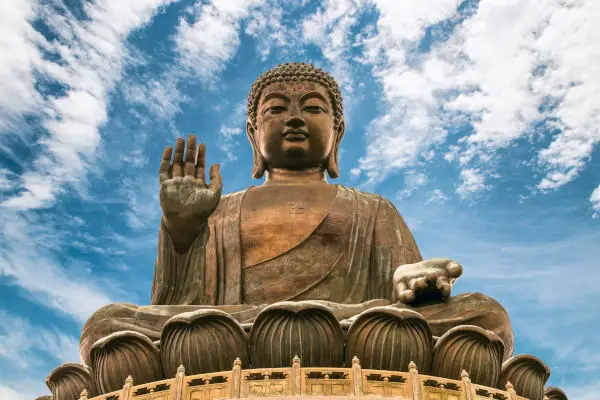
Symbolism in the Statue
The Tian Tan Buddha is a symbol of enlightenment and compassion in Buddhism. Seated atop a lotus throne, the statue exudes serenity and wisdom. The raised right hand signifies fearlessness, while the left hand, resting on the lap, represents meditation and inner peace.
The lotus flower itself, a symbol of purity and enlightenment, adds another layer of symbolism to the statue. The Tian Tan Buddha is a visual representation of Buddhist principles that resonate with locals and visitors seeking spiritual solace.
Artistic Details and Cultural Impact
The bronze statue, with its intricate features and the flowing robes that cascade gracefully, reflects the fusion of traditional Buddhist artistry with contemporary craftsmanship. Beyond its aesthetic appeal, the statue has a profound cultural impact, serving as a symbol of Hong Kong’s religious diversity and a testament to the importance of spiritual contemplation in modern urban life.
As visitors ascend the steps to reach the Tian Tan Buddha, they partake in a journey of self-reflection and spiritual exploration. The statue has become a cultural icon, embodying the shared values of tolerance, peace, and mindfulness in the vibrant tapestry of Hong Kong.
| Location | Lantau Island, Hong Kong |
| Height | 34 meters (112 feet) |
| Sculptor | Unknown |
| Material | Bronze |
| Completed | Construction completed in 1993 |
| Coordinates | 22.2535° N, 113.9049° E |
| Nearby attractions | Po Lin Monastery, Ngong Ping 360, Wisdom Path |
| Best season for a visit | Autumn and winter |
20. Laozi Statue in Yuanxuan Taoist Temple Guangzhou
Within the serene halls of the Yuanxuan Taoist Temple in Guangzhou stands the Laozi Statue, paying homage to the revered philosopher Laozi. The historical context of this statue is deeply rooted in Taoist philosophy, which emerged during ancient China’s formative years. Laozi, credited with the authorship of the Tao Te Ching, laid the groundwork for Taoist thought, and the statue stands as a testament to his enduring influence on Chinese culture.

Symbolism in the Statue
The Laozi Statue is rich in symbolism, encapsulating the essence of Taoist teachings. Laozi is often depicted as an elderly figure with flowing robes, reflecting the simplicity and humility that are central tenets of Taoism. The statue’s serene countenance and poised demeanor symbolize the tranquility and wisdom inherent in Laozi’s philosophy.
Artistic Details and Cultural Impact
The intricate details, from the facial features to the folds of the robe, exemplify the dedication to capturing the spirit of Laozi’s teachings. The cultural impact of the statue resonates within the temple, creating a sacred space for worshippers and visitors to connect with Taoist wisdom and find solace in the philosophy of simplicity and harmony.
| Location | Yuanxuan Taoist Temple, Guangzhou |
| Material | Bronze |
| Coordinates | 23°24’05.0″N 113°10’47.8″E |
| Nearby attractions | Bright Filial Piety Temple, Six Banyan Trees Temple |
| Best season for a visit | Spring and autumn |
21. Mao Zedong statue at Orange Isle in Xiang River.
Amidst the scenic beauty of Orange Isle in the Xiang River, the Mao Zedong Statue stands as a testament to an era of revolutionary change in China. Erected in 2009, the statue commemorates Mao Zedong, the founding father of the People’s Republic of China, and a central figure in the Chinese Communist Party. The statue was made following a 1925 photo of Mao Zedong when he was younger.
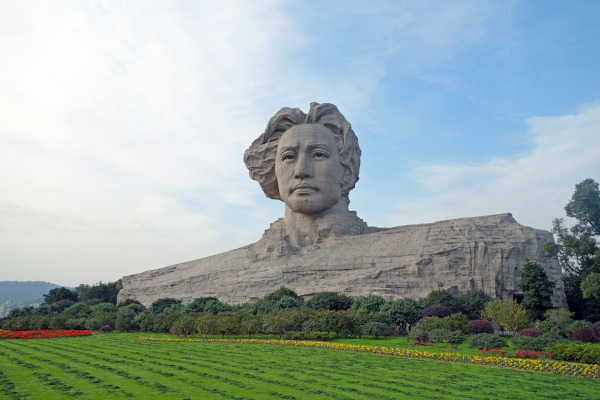
Symbolism in the Statue
The Mao Zedong’s Head Statue is a symbolic representation of Mao’s enduring influence on China’s trajectory. The disembodied head, towering over the landscape, symbolizes the larger-than-life impact Mao had on the nation. The absence of the full figure emphasizes the idea that Mao’s legacy transcends physical presence, permeating the collective consciousness of the people. The statue’s placement on Orange Isle adds another layer of symbolism, connecting Mao to the scenic beauty of the Xiang River and the historical significance of the site.
Artistic Details and Cultural Impact
Crafted with a distinctive artistic vision, Mao Zedong’s Head Statue showcases a departure from traditional representations. The exaggerated scale of the head and the meticulous detailing in facial features create a powerful artistic statement.
The cultural impact of the Mao Zedong Statue extends to Orange Isle itself, transforming it into a place of historical resonance and patriotic sentiment. Locals and tourists alike visit the site to engage with the history it represents and to ponder the legacy of Mao Zedong in shaping the modern Chinese state.
| Location | Orange Isle, Xiang River, Changsha, Hunan Province, China |
| Height | 32 meters (105 feet) |
| Material | Bronze |
| Completed | Unveiled in 2009 |
| Coordinates | 28°10’03.4″N 112°57’37.7″E |
| Nearby attractions | Yuelu Mountain, Aiwan Pavilion, Juzizhou Islet |
| Best season for a visit | Spring and autumn |
22. Largest copper coin sculpture at Hunan Baoshan
Nestled in the picturesque landscape of Hunan Baoshan, the Largest Copper Coin Sculpture is a contemporary marvel that adds a unique dimension to China’s rich cultural tapestry. Erected in 2013, the sculpture is a testament to China’s historical connection to currency and trade.
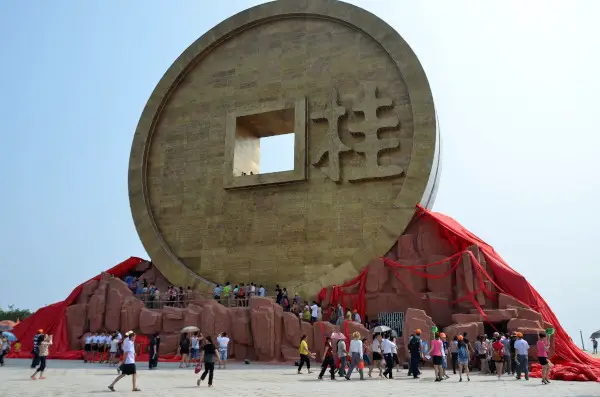
Symbolism in the Sculpture
Shaped like a traditional Chinese coin, the sculpture symbolizes prosperity, wealth, and good fortune. The oversized dimensions underscore the significance of currency in Chinese culture and history, transcending mere representation to become a symbolic guardian of economic prosperity. The choice of copper, a historically valued metal, adds layers of meaning, connecting the sculpture to traditional beliefs associated with material wealth.
Cultural Impact
The cultural impact of the sculpture is multi-faceted. As a contemporary art installation, it reflects China’s dynamism and creativity. Moreover, it invites contemplation on the interplay between traditional symbolism and the modern world, prompting viewers to explore the changing meanings associated with currency in a global context.
| Location | China, Hunan, Chenzhou, Guiyang County |
| Height | 24 meters (78.7 feet) |
| Material | Steel structure with copper sheets on the exterior |
| Completed | 2013 |
| Coordinates | 25°44’27.6″N 112°42’57.0″E |
| Nearby attractions | Dongzhou Crystal Village, Chenzhou Bamboo Sea, Dazhushan Scenic Area |
| Best season for a visit | Spring, Autumn |
23. Equestrian statue of Zheng Chenggong in Quanzhou
In the heart of Quanzhou, the Equestrian Statue of Zheng Chenggong stands as a powerful tribute to a historical figure who left an indelible mark on China’s maritime history. This massive monument is visible from almost anywhere in the city. Zheng Chenggong, also known as Koxinga, was a Ming loyalist who played a crucial role in resisting foreign invasions during the 17th century.
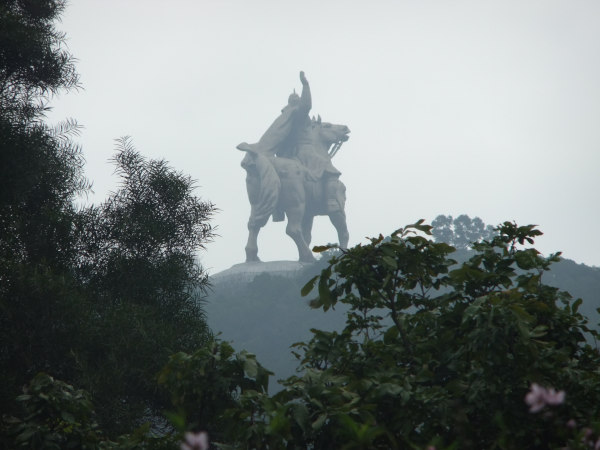
Symbolism in the Statue
The Equestrian Statue of Zheng Chenggong is rich in symbolism, embodying the military prowess and resilience of its subject. Zheng Chenggong is depicted on horseback, a symbol of leadership and mobility, reflecting his strategic acumen and battlefield prowess.
Artistic Details and Cultural Impact
From the flowing mane of the horse to the intricate details of Zheng Chenggong’s attire, every element contributes to the visual narrative. The cultural impact of the statue extends beyond aesthetics; it becomes a symbol of local pride and a connection to Quanzhou’s maritime heritage. As a cultural landmark, the statue evokes a sense of historical continuity, reminding people of the city’s pivotal role in shaping China’s maritime destiny.
| Location | Quanzhou, Fujian |
| Height | 38m (125 ft.) |
| Material | Metal-plate construction |
| Completed | 2001 |
| Coordinates | 24°54’08.2″N 118°37’25.5″E |
| Nearby attractions | Kaiyuan Temple, Quanzhou Maritime Museum, Luoyang Bridge |
| Best season for a visit | Autumn, Spring |
End Words
As we traverse the expansive landscape of China’s great statues, we witness a harmonious interplay between history, culture, and art. Each sculpture, whether ancient or contemporary, stands as a testament to the indomitable spirit of a nation that cherishes its rich heritage. In the silhouette of these statues, we find not only an artistic legacy but a living chronicle of China’s journey through time. These great statues are not merely monuments; they are storytellers etching tales of a civilization that continues to sculpt its destiny.
An Introduction to Chinese History & Culture (Aff.link)
Dive into China’s rich past and intriguing present! From ancient dynasties to modern powerhouses, uncover Chinese culture facts, pivotal moments, and the captivating tales that have shaped this vast nation.
Stay in Touch
 Join our newsletter by using the forms on this website or click here!
Join our newsletter by using the forms on this website or click here! Follow us on Google News
Follow us on Google News Follow us on Facebook
Follow us on Facebook
Feature Image from Depositphotos

